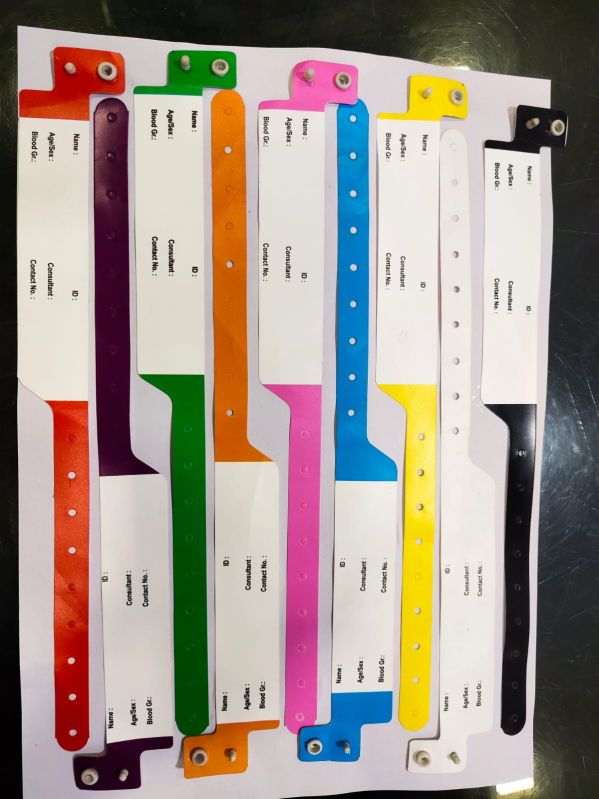The Purpose of Patient Identification Band in Streamlining Hospital Operations
The Purpose of Patient Identification Band in Streamlining Hospital Operations
Blog Article
A Comprehensive Guide to Patient Identification Band as a Vital Medical Supply
In the substantial landscape of healthcare, Patient Identification bands have actually become a crucial device (patient identification band). These bands, teeming with necessary information, offer as the initial line of protection versus clinical mistakes and make certain smooth Patient treatment. As we begin to discover these medical supplies in deepness, we uncover the intricacies of their style, usage, and influence on Patient security, while meaning the assurance they hold for future clinical methods
The Duty of Patient Identification Bands in Medical Care
The relevance of Patient Identification bands in health care can not be overstated. These easy wristbands act as the primary approach of ensuring Patient identification, lowering the danger of clinical mistakes and improving total Patient security. They are a crucial device in validating a client's identity prior to carrying out treatments, drugs, or carrying out treatments. They are usually color-coded to represent various health problems, allergic reactions, or threat elements, allowing for quick aesthetic Identification by healthcare professionals. In the fast-paced, high-pressure world of healthcare, where human lives go to stake, the advantages of such a basic yet efficient device are invaluable. Patient Identification bands supply a system of checks and balances, a fail-safe against potential errors, and a constant suggestion of the private behind the therapy.
Deciphering the Information on Patient Identification Bands
While they may seem basic at a look, Patient Identification bands bring important details that can substantially influence the course of a client's treatment. These bands commonly present the Patient's name, day of birth, and a distinct identifier, such as a clinical record number. These crucial pieces of details guarantee right Patient Identification, protecting against clinical mistakes. Some bands might also consist of vital clinical signals, such as allergic reaction information, which can be vital in preventing adverse reactions. Furthermore, the barcode discovered on these bands can be scanned to access the Patient's electronic wellness document, supplying a wealth of info to health care companies. Comprehending the info on these bands is vital for secure and reliable Patient treatment.
Various Types of Patient Identification Bands: A Closer Appearance
In the world of Patient Identification, there are several kinds of bands that serve distinct purposes. Barcode Identification Bands, RFID Tag-based Bands, and Color-Coded Patient Bands are the key categories - patient identification band. Each kind offers unique features and benefits, which will certainly be taken a look at in the adhering to areas
Barcode Identification Bands
Providing a considerable improvement in Patient security, barcode Identification bands have ended up being an important instrument in the clinical field. These bands shop vital Patient data in a barcode style that's rapidly available with a scan. This decreases the possibility of human mistake in Patient Identification and information access, which is important in medical treatments. The barcode system makes information like Patient name, clinical history, allergies, and prescribed medicines readily offered. This guarantees quick and correct Patient Identification, specifically in emergency situation situations where every 2nd matters. Barcode Identification bands are also very easy to utilize, resilient and cost-effective, making them an important component of contemporary medical care. Significantly, these bands have substantially reduced medical errors and enhanced Patient safety.
RFID Tag-based Bands
Another ingenious strategy in Patient Identification is the use of RFID Tag-based bands. These bands make use of Radio Regularity Identification (RFID) technology to supply a safe and secure type of Patient Identification. Unlike barcodes, RFID tags can keep far more info and can be checked out without straight line of vision. This implies that health care specialists can access crucial Patient information, even if the band is obscured by clothes or bed linens. RFID tags can be reprogrammed with updated information as needed, improving their capability. Nonetheless, these bands can be a lot more expensive than other forms of Identification, and there are personal privacy problems associated with making use of RFID innovation. In spite of these difficulties, RFID tags provide significant capacity for improving Patient safety and security and other performance in medical care.
Color-Coded Patient Bands
Color-coded Patient bands stand as a basic yet effective device in Patient Identification. These bands, widespread in healthcare facilities and facilities, utilize various colors to show different Patient allergies, risks or conditions, guaranteeing instant recognition by medical care specialists. Hence, the color-coded Patient band system is a crucial part of Patient security and effective healthcare shipment.

Usage of Patient Identification Bands: Procedures and Protocols
In healthcare settings, making use of Patient Identification bands plays a crucial role in guaranteeing Patient safety and security and decreasing medical errors. These bands, normally made from resilient, hypoallergenic material, are connected to the Patient's wrist or ankle joint, displaying critical information such as name, date of birth, and an unique identifier. The process is generally performed during admission, with the details double-checked for precision. For newborns, bands are affixed to both the baby and mommy to protect against mismatches. In elderly care, two bands might be made use of for individuals with mental deterioration to make certain correct Identification. Adhering to these protocols helps to avoid Patient misidentification, a precursor to significant clinical mistakes. This technique is a testimony to the important nature of Identification bands in Patient treatment.
The Effect of Identification Bands on Patient Security
Identification bands play a critical function in keeping Patient security in health care settings. Their usage can considerably lower medical mistakes by making certain that the appropriate Patient receives the proper treatment. These easy devices contribute to improving the top quality of treatment by providing an extra layer of confirmation to Patient identities.
Lowering Clinical Mistakes
An astonishing number of clinical mistakes, estimated to be in the numerous thousands every year, can be mapped back to misidentification of patients. These errors lead not just to damage to the Patient however additionally result in costly lawful and reputational problems to the medical care establishment. Patient Identification bands have become an important tool in considerably lowering these mistakes. They provide an easy, yet efficient, method of correctly identifying individuals. Most importantly, these bands make certain that every Patient is appropriately matched with their medical documents, tests, and therapies, consequently considerably lowering the threat of clinical mistakes. By ensuring exact Patient Identification, these bands add to enhanced Patient safety and security, building trust and self-confidence in the medical care system.
Making Certain Correct Therapy
Guarding Patient safety, Identification bands play a crucial duty in ensuring the appropriate administration of therapies. They provide a basic yet efficient technique for correctly determining people and matching them to their medical records. This minimizes the risk of therapy errors, specifically in high-pressure scenarios where mistakes can have extreme consequences. These bands include vital details such as the Patient's name, day of birth, and unique Identification number. Subsequently, they assist in accurate site cross-referencing with electronic health documents, prescription orders, and procedural timetables. In consequence, the possibility of misdiagnosis, medication errors, or step-by-step mix-ups is considerably reduced. Essentially, Patient Identification bands serve as a crucial secure in the healthcare setup, dramatically adding to Patient safety and security and making certain proper treatment.

Enhancing Top Quality Care
While they might appear unimportant, patient Identification bands greatly enhance the quality of care provided in medical care settings. They are an important tool in guaranteeing Patient safety and security due to their ability to provide prompt accessibility to essential details. The fostering of Patient Identification bands is, therefore, a needed action in all medical care atmospheres.
Exploring the Future of Patient Identification Bands in Medical Technique

Final thought
Patient Identification bands play a vital function in healthcare, making sure exact Patient Identification and reducing medical errors. These vital devices increase safety and security and supply immediate access to crucial wellness information. The integration of digital and biometric modern technologies could further improve Patient safety, treatment quality, and personal privacy. As medical methods proceed to develop, Patient Identification bands will certainly remain a critical part of the medical care system.
While they may appear straightforward at a glance, Patient Identification bands carry crucial details that can greatly impact the training course of a client's treatment.Color-coded Patient bands stand as a straightforward yet reliable tool in Patient Identification.In health care setups, the usage of Patient Identification bands plays a pivotal role in guaranteeing Patient safety and security and lowering clinical errors. In essence, Patient Identification bands serve as an important safeguard in the medical care setup, considerably adding to Patient safety and security and ensuring proper therapy.
Patient Identification bands play a vital function in health care, guaranteeing accurate Patient Identification and reducing clinical mistakes.
Report this page